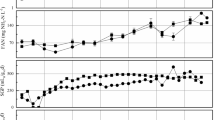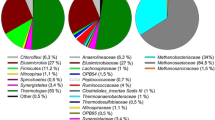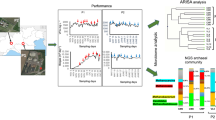Abstract
Microbial community dynamics during the anaerobic co-digestion of pig manure, pasteurized slaughterhouse waste and glycerin were studied in a lab-scale CSTR. The feed composition was optimized through progressive co-substrate additions for enhanced methane production and organic matter removal without accumulation of intermediate compounds. Microbial community structure of biomass samples was studied by means of qPCR and DGGE profiling of 16S rRNA genes (Bacteria and Archaea), and genus-specific qPCR of the methyl coenzyme M reductase gene (mcrA), which encodes for an enzyme universally involved in methanogenesis. The composition of the dominant bacterial populations remained relatively stable, when compared to those in the influent, but the highest changes were observed upon the introduction of glycerin. Biodiversity of archaea was restricted to a few representatives of the genera Methanosaeta and Methanosarcina, but Methanospirillum sp. was detected only when glycerin was introduced in the feeding. Glycerin supplementation coincided with the strongest increase in methane yield (from 0.22 to 0.64 m3CH4 m−3 d−1).



Similar content being viewed by others
Abbreviations
- ABP:
-
Animal by-products
- CODt:
-
Total chemical oxygen demand
- CSTR:
-
Continuous stirred tank reactor
- DGGE:
-
Denaturing gradient gel electrophoresis
- HRT:
-
Hydraulic retention time
- mcrA:
-
Methyl-coenzyme M reductase
- Msar:
-
Methanosarcinaceae
- Msae:
-
Methanosaetaceae
- LCFA:
-
Chain fatty acids
- OLR:
-
Organic loading rate
- PCR:
-
Polymerase chain reaction
- PM:
-
Pig manure
- PP-ABP:
-
Pasteurized animal by-product
- qPCR:
-
Quantitative time PCR
- RG:
-
Residual glycerin
- rRNA:
-
Ribosomal ribonucleic acid
- TA:
-
Total alkalinity
- TS:
-
Total solids
- VFA:
-
Volatile fatty acids
- VS:
-
Volatile solids
References
Stams AJM, Zehnder AJB (1990) Ecological impact of syntrophic alcohol and fatty acid oxidation. Microbiol Biochem Strict Anaerob Involved Interspecies Hydrog Transfer Federation Euro Microbiol Soc Symp Ser 54:87–98
Supaphol S, Jenkins SN, Intomo P, Waite IS, O’Donnell AG (2011) Microbial community dynamics in mesophilic anaerobic co-digestion of mixed waste. Bioresour Technol 102:4021–4027
Fernández A, Huang S, Seston S, Xing J, Hickey R, Criddle C, Tiedje J (1999) How stable is stable? Function versus community composition. Appl Environ Microbiol. 65(8):3697–3704
Álvarez R, Liden G (2008) Semi- continuous co-digestion of solid slaughterhouse waste, manure and fruit and vegetable waste. Renew Energ 33:726–734
Kougias PG, Treu L, Campanaro S, Zhu X, Angelidaki I (2016) Dynamic functional characterization and phylogenetic changes due to long chain fatty acids pulses in biogas reactors. Sci Rep 6:28810
Rodriguez-Abalde A, Flotats X, Fernandez B (2017) Optimization of the anaerobic co-digestion of pasteurized slaughterhouse waste, pig slurry and glycerine. Waste Manage 61:521–528
Silvestre G, Rodríguez-Abalde A, Fernández B, Flotats X, Bonmatí A (2011) Biomass adaptation over anaerobic co-digestion of sewage sludge and trapped grease waste. Bioresour Technol 102:6830–6836
Hartmann H, Ahring BK (2006) Strategies for the anaerobic digestion of the organic fraction of municipal solid waste: an overview. Wat Sci Technol 53:7–22
Salminen EA, Rintala JA (2002) Semi-continuous anaerobic digestion of solid poultry slaughterhouse waste: effect of hydraulic retention time and loading. Water Res 36:3175–3182
Edström M, Norberg A, Thyselius L (2003) Anaerobic treatment of animal byproducts from slaughterhouses at laboratory and pilot scale. Appl Bioch Biotechnol 109:127–138
Amon B, Kryvoruchko V, Bodiroza V, Pötsch E, Zollitsch W (2006) Optimising methane yield from anaerobic digestion of manure: effects of dairy systems and of glycerine supplementation. Int Congr Ser 1293:217–220
Mladenovska Z, Hartmann H, Kvist T, Sales-Cruz M, Gani R, Ahring BK (2006) Thermal pretreatment of the solid fraction of manure: impact on the biogas reactor performance and microbial community. Water Sci Technol 53:59–67
Jimenez J, Theuerl S, Bergmann I, Klocke M, Guerra G, Romero-Romero O (2016) Prokaryote community dynamics in anaerobic co-digestion of swine manure, rice straw and industrial clay residuals. Water Sci Technol 74(4):824–835
Ren J, Yuan X, Li J, Ma X, Zhao Y, Zhu W, Wang X, Cui Z, (2014) Performance and microbial community dynamics in a two-phase anaerobic co-digestion system using cassava dregs and pig manure. Bioresour Technol 155:342–351
Conklin A, Stensel DH, Ferguson J (2006) Growth Kinetics and Competition between methanosarcina and methanosaeta in mesophilic anaerobic digestion. Water Environ Res 78(5):486–496
European Community (2009) Regulation (EC) no 1069/2009 of the European parliament and of the council of October 2009 laying down health rules as regards animal by-products and derived products not intended for human consumption and repealing regulation (EC) No 1774/2002 (Animal by-products Regulation)
European Community (2011) Commission Regulation (EU) No 142/2011 of 25 February 2011 implementing Regulation (EC) No 1069/2009 of the European parliament and of the council laying down health rules as regards animal by-products and derived products not intended for human consumption and implementing Council Directive 97/78/EC as regards certain samples and items exempt from veterinary checks at the border under that directive. https://eur-lex.europa.eu/legal-content/EN/TXT/?uri=uriserv:OJ.L_.2011.054.01.0001.01.ENG
APHA AWWA WEF (1995) Standard methods for the examination of water and waste water. American Public Health Association /American Water Works Association/Water Environment Federation. 19th edn, Washington. https://store.awwa.org/store/productdetail.aspx?productid=28493774
Noguerol-Arias J, Rodríguez-Abalde A, Romero-Merino E, Flotats X (2012) Determination of chemical oxygen demand in heterogeneous solid or semisolid samples using a novel method combining solid dilutions as a preparation step followed by optimized closed reflux and colorimetric measurement. Anal Chem 84:5548–5555
Palatsi J, Illa J, Prenafeta-Boldú FX, Laureni M, Fernández B, Angelidaki I, Flotats X (2010) Long-chain fatty acids inhibition and adaptation process in anaerobic thermophilic digestion: batch tests, microbial community structure and mathematical modeling. Bioresour Technol 101(7):2243–2251
Sievers D, Brune D (1978) Carbon/nitrogen ratio and anaerobic digestion of swine waste. Trans ASAE 21(3):537–549
Sotres A, Díaz- Marcos J, Guivernau M, Illa J, Magrí A, Prenafeta-Boldú F, Bonmatí A, Viñas M (2015) Microbial community dynamics in two-chambered microbial fuel cells: effect of different ion exchange membranes. J Chem Technol Biotechnol 90(8):1497–1506
Robra S, Serpa da Cruz R, De Oliveira A, Almeida J, Santos J (2010) Generation of biogas using crude glycerin from biodiesel production as a supplement to cattle slurry. Biomass Bioen 34:1330–1335
Rétfalvi T, Tukacs-Hájos A, Albert L, Marosvölgyi B (2011) Laboratory scale examination of the effects of overloading on the anaerobic digestion by glicerol. Bioresour Technol 102(8):5270–5275
Fountoulakis M, Petousi I, Manios T (2010) Co-digestion of sewage sludge with glycerol to boost biogas production. Waste Manage 30(10):1849–1853
Angelidaki I, Ellegaard L, Ahring BK (1998) A comprehensive model of anaerobic bioconversion of complex substrates to biogas. Biotechnol Bioeng 63:363–372
Friedrich MW (2005) Methyl-coenzyme M reductase genes: unique functional markers for methanogenic and anaerobic methane-oxidizing Archaea. Methods Enzymol 397:428–442
Mladenovska Z, Dabrowski S, Ahring BK (2003) Anaerobic digestion of manure and mixture of manure with lipids: biogas reactor performance and microbial community analysis. Water Sci Technol 48(6):271–278
Scheff G, Salcher O, Lingens F (1984) Trichococcus Flocculiformis gen. nov., sp. nov. In validation of the publication of new names and new combinations previously effectively published outside the IJSB, list no. 15. Int J Syst Bacteriol 34:355–357
Liu JR, Tanne RS, Schumann P, Weiss N, McKenzie CA, Janssen PH (2002) Emended description of the genus Trichococcus, description of Trichococcus collinsii sp. nov., and reclassification of Lactosphaera pasteurii as Trichococcus pasteurii comb. nov. and of Ruminococcus palustris as Trichococcus palustris comb. nov. in the low-G+C Gram-positive bacteria. Int J Syst Evol Microbiol 52:1113–1126
Grabowski A, Tindall BJ, Bardin V, Blanchet D, Jeanthon C (2005) Petrimonas sulfuriphila gen. nov., sp. nov., a mesophilic fermentative bacterium isolated from a biodegraded oil reservoir. Int J Syst Evol Microbiol 55:1113–1121
Horn N (1987) Clostridium disporicum sp. nov. a saccharolytic species able to form two spores per cell, isolated from a rat cecum. Int J Syst Bacteriol 37(4):398–401
Peu P, Brugère H, Pourcher A-M, Kérourédan M, Godon J-J, Delgenè J-P, Dabert P (2006) Dynamics of a pig slurry microbial community during anaerobic storage and management. Appl Environ Microbiol 72(5):3578–3585
Leung K, Topp E (2001) Bacterial community dynamics in liquid swine manure during storage: molecular analysis using DGGE/PCR of 16S rDNA. FEMS Microbiol Ecol 38:169–177
Chachkhiani M, Dabert P, Abzianidze T, Partskhaladze G, Tsiklauria L, Dudauri T, Godon JJ (2004) 16S rDNA characterisation of bacterial and archaeal communities during start-up of anaerobic thermophilic digestion of cattle manure. Biores Techn 93(3):227–232
Kröber M, Bekel T, Diaz NN, Goesmann A, Jaenicke S, Krause L, Miller D, Runte KJ, Viehover P, Puhler A, Schlüter A (2009) Phylogenetic characterization of a biogas plant microbial community integrating clone library 16S-rDNA sequences and metagenome sequence data obtained by 454-pyrosequencing. J Biotechnol 142:38–49
Weiß S, Zankel A, Lebuhn M, Petrak S, Somitsch W, Guebitz GM (2011) Investigation of mircroorganisms colonising activated zeolites during anaerobic biogas production from grass silage. Bioresour Technol 102:4353–4359
Ahring BK (1995) Methanogenesis in thermophilic biogas reactors. Antonie Van Leeuwenhoek 67(1):91–102
Ferry JG, Smith PH, Wolf RS (1974) Methanospirillum, a new genus of methanogenic bacteria, and characterization of methanospirillum hungatii sp.nov. Int J Syst Evol Microbiol 24:465–469
Jarvis GN, Moore ER, Thiele JH (1997) Formate and ethanol are the major products of glycerol fermentation produced by a Klebsiella planticola strain isolated from red deer. J Appl Microbiol 83:2166–2174
Acknowledgements
This work was supported by the Spanish Ministry of Science and Innovation (project PROBIOGAS PSE-120000–2008-57v). The support of the CERCA Program and of the Consolidated Research Group TERRA (ref. 2017 SGR 1290), both from the Generalitat de Catalunya, is also acknowledged.
Author information
Authors and Affiliations
Corresponding author
Ethics declarations
Conflict of interest
The authors declare that they have no conflict of interest.
Additional information
Publisher's Note
Springer Nature remains neutral with regard to jurisdictional claims in published maps and institutional affiliations.
Rights and permissions
About this article
Cite this article
Rodríguez-Abalde, Á., Guivernau, M., Prenafeta-Boldú, F.X. et al. Characterization of microbial community dynamics during the anaerobic co-digestion of thermally pre-treated slaughterhouse wastes with glycerin addition. Bioprocess Biosyst Eng 42, 1175–1184 (2019). https://doi.org/10.1007/s00449-019-02115-8
Received:
Revised:
Accepted:
Published:
Issue Date:
DOI: https://doi.org/10.1007/s00449-019-02115-8




